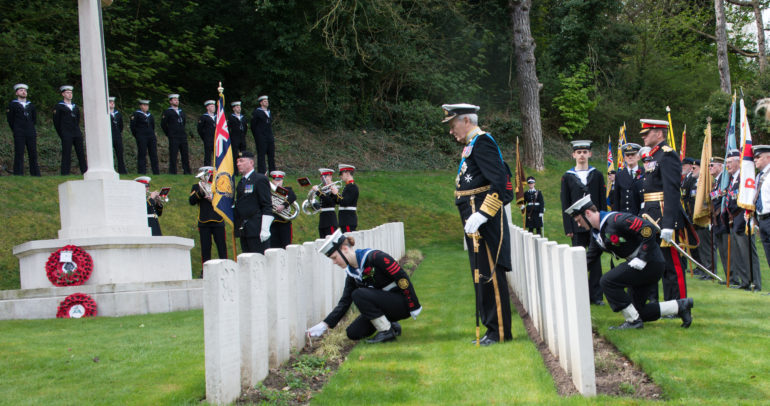每年 23RD 四月多佛(April Dover)对此表示感谢,并尊重那些当天在Zeebrugge的痣中战斗和死亡的男人 1918. 当前的Covid-19限制意味着传统的纪念活动无法进行. 今年,我们正在保护社区中的弱势群体,包括我们的退伍军人和学员部队的年轻人,他们通常会在圣詹姆斯公墓和多佛市政厅外参加服务,并在多佛市政厅外面敲响了市长的Zeebrugge Bell。.
今年请尊敬您在家中堕落的人.
Zeebrugge引用, 在多佛(Dover)的纪念行为中,每年都会阅读Kohima祈祷和颂歌.
我们的照片显示了五渔港的监狱长, 舰队海军上将Boyce KG GCB OBE DL在一百周年纪念期间向圣詹姆斯公墓休息的每个倒下的人致敬 2018.
Zeebrugge引用
午夜在圣. 乔治节 1918, 确切地
102 几年前, 今天, 英国皇家海军和
皇家海军陆战队最多
大胆的战争突袭.
否认敌人的使用,
皇家海军陆战队和“蓝衣”冲进了
Zeebrugge的痣.
在空白范围内面对猛烈的火。
强化的敌人, 他们战斗了上岸,
表现出色, 极端勇敢和真实
英国精神.
那些勇敢的人继续吸引敌人
他们的同事将船撞到入口处
运河, 有效地阻止它们
战争的其余部分.
违反所有困难, 他们的行动成功了,但在
许多生命的成本. 它覆盖了皇家海军
带有新的荣耀和八个维多利亚十字架
在一个持续一个多小时的动作中授予.
那天晚上, 英国向世界展示了他们如何
可以为比利时和欧洲的自由而战和死亡.
我们记得在上帝面前,并赞扬他的维持,
所有水手和海军陆战队的记忆
谁为自己的国家献出了生命
在 23RD 四月 1918.
Kohima祈祷
当你回家的时候,
告诉他们我们说,
为你的明天,
我们今天给了我们.
颂歌 (讲道)
他们不会变老,
因为我们剩下的年龄:
年龄不会厌倦他们
也不是谴责的年份.
在阳光下,
早上,
我们会记住他们
对Zeebrugge摩尔的突袭的历史背景 23RD 四月 1918
经过 1917, U型船突袭大西洋的运输车道, the North Sea and the English Channel were sinking up to 400 ships a month, threatening the supplies of food and war materials vital to the war effort.
The U-boats were based in heavily fortified pens at Bruges and accessed the Channel via an eight-mile canal to the port of Zeebrugge, and an older, narrower canal to Ostend. At the time, Zeebrugge was the world’s largest man-made harbour, extending a mile and a half out to sea.
Attempts to block submarine access to the port with bombing, shelling, minefields and net barrages had failed, so the Royal Navy hatched a plan to scuttle three old cruisers, filled with concrete, in the entrance of the canal at Zeebrugge to prevent the U-boats accessing their home base to refit, resupply, rearm and refuel.
The 75-strong British armada, commanded by Vice Admiral Roger Keyes, was led by HMS Vindictive, an Arrogant-class cruiser, supported by two submarines and a flotilla of smaller craft, including two former Mersey ferries, which made ideal landing craft. The force of volunteers who took part in the raid consisted of 82 officers, 1,000 sailors and 700 marines.
Things soon started to go wrong. The diversionary attack on the harbour was supposed to be covered by a smokescreen, but thanks to an unexpected change of wind direction the smoke blew away and German gunners on the mole were able to continue to fire at the invaders at close range, inflicting many casualties as the marines sought to seize and destroy the gun emplacements, engaging them at close quarters.
The strong current made it difficult for HMS Vindictive to discharge men on the breakwater and the landing craft were severely damaged, suffering many casualties as they tried to get the raiders ashore. In total, 277 男子被杀, 356 受伤.
The crews of two of the blockships did manage to get to the entrance of the inner harbour and sink them but did not fully block it. The Germans were able to dredge a new channel round the obstacles and the port was back in operation within days. German casualties were just eight dead and 16 受伤.
A simultaneous raid on Ostend failed but the Royal Navy returned in May to try again, when the HMS Vindictive was sunk in an attempt to block the port.
Both sides claimed success, the Germans maintaining that U-boats were able to pass the scuttled wreck within two days. 然而, Winston Churchill insisted that the action had severely curtailed submarine operations against Allied shipping and described the raid as “the finest feat of arms of the Great War”.
Eleven Victoria Crosses and hundreds of other decorations were awarded to those who took part in the attacks. Most of the Zeebrugge casualties were buried in England either because they died of their wounds en route or because the survivors recovered their bodies to repatriate them. HMS Vindictive returned the majority to Dover, where 156 bodies were kept in a makeshift morgue in the town’s Market Hall. A mass funeral took place at St James’s Cemetery, 多佛, 上 27 四月, 1918 with sailors and marines buried in one mass grave under the spur that overlooks the cemetery from the south-west. The Zeebrugge plot of St James’s Cemetery, 多佛, has nine unidentified men and 50 named men who died on 23 四月 1918 but most fatalities were returned to their families for local burials. On his request, Keyes was buried here beside his men following his death on 26 十二月 1945. Four Royal Navy personnel who died in the raid are buried in the cemetery at Zeebrugge where there is also a memorial to the raid.
Shortly after Zeebrugge was liberated by advancing Allied troops in October 1918, The ‘Zeebrugge Bell’ was given to Dover’s Mayor, Edwin Farley by Vice Admiral Keyes. It had served as an alarm bell on the mole and was given to Keyes to pass to Dover by Albert I, The King of the Belgians, as a souvenir of the raid and a tribute to the heroism of the attackers. The bell was first placed at St Mary’s Church but in 1921 it was moved to the Grade I listed Maison Dieu. 在 1933, the bell briefly returned to St Mary’s Church for a special service broadcast on BBC radio.
